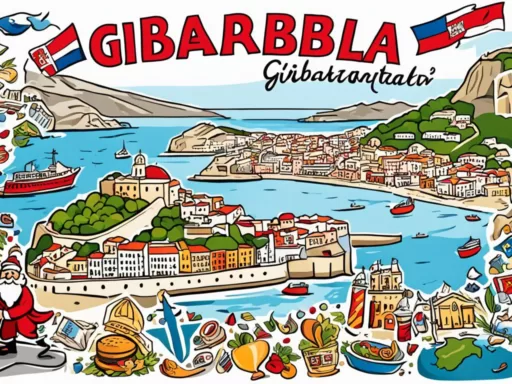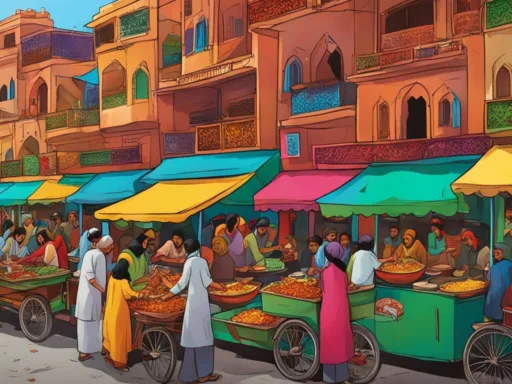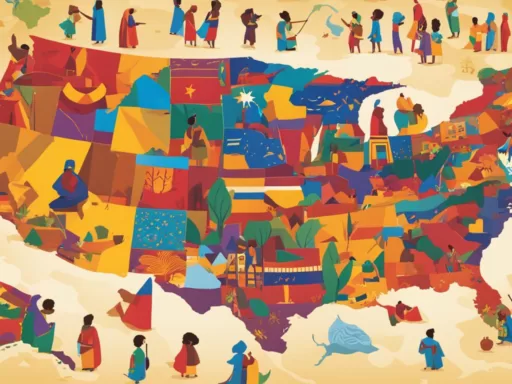While the tiny Principality of Liechtenstein may seem unassuming on the map, its linguistic landscape is nothing short of extraordinary. Nestled between Switzerland and Austria, this small country hosts a rich palette of languages, belying its size with a surprisingly broad linguistic diversity. Beyond the evident dominance of German, the languages spoken in Liechtenstein include a spectrum of dialects and immigrant languages that paint a vivid picture of the principality’s cultural richness.
Intrigued? Liechtenstein’s official language, German, takes on unique local colors due to the prevalence of dialects like Highest Alemannic, High Alemannic, and Walser German. Yet, the language diversity Liechtenstein is known for extends even further. The community languages spoken here, such as Italian, Turkish and Portuguese, echo the tales of migration and the fostering of an inclusive society. In this cultural enclave, language is as much about communication as it is about identity and heritage.
Ready to unravel the surprising language threads that weave together this country’s social fabric? Let us delve into the linguistic wonders of Liechtenstein.
Key Takeaways
- German is the official language of Liechtenstein, but it’s just the tip of the linguistic iceberg.
- Regional dialects, including Highest Alemannic and Walser German, lend a special linguistic identity to the principality.
- Immigrant languages such as Italian and Turkish contribute to the rich language diversity Liechtenstein boasts.
- Understanding the unique language dynamics in Liechtenstein provides insights into its history and cultural complexities.
- Language acts as a bridge between traditional heritage and the increasingly multicultural fabric of the country.
- The intricate linguistic landscape of Liechtenstein is a testament to European microstates’ cultural and historical depth.
The Official Language: A Deep Dive into German’s Role in Liechtenstein
As the beacon of Liechtenstein’s linguistic sphere, the German language stands as the official conduit of communication, law, and education. With its multifaceted usage across various domains of public life, German shapes the country’s identity, serving as an anchor to European linguistic traditions while adapting to the local context through its dialects.
The Predominance of Standard German and Official Uses
In Liechtenstein, Standard German operates as more than just a means of conversation; it is the backbone of formalities, governing processes, and educational frameworks. This predominance not only aligns with broader European norms but also is indicative of Liechtenstein’s dedication to maintaining high standards of communication within official realms.
Alemannic Dialects: Understanding Regional Linguistic Nuances
The tapestry of Liechtenstein’s linguistics is richly embroidered with Alemannic dialects, which bear a close relation to Swiss German. These dialects serve as a cultural touchstone, remaining prevalent in the day-to-day vernacular and preserving the intimacy of regional discourse amidst the globalizing influences around them.
Functional Bilingualism: Standard German in Public and Dialects in Private
Within the quaint borders of Liechtenstein, a distinctive form of bilingualism unfolds, where Standard German prevails in public and professional interactions, while the endearing Alemannic dialects flourish within the comfort of homes and community gatherings. This dimension of linguistic practice underlines a versatile identity, harmoniously blending formality with locality.
Liechtenstein’s commitment to bilingualism is not merely a practice but a celebration of its heritage. It fosters a community where the official languages Liechtenstein embraces coexist symbiotically with the intimate Alemannic dialects Liechtenstein cherishes. Here, language is both a passport to the wider world and a ticket home.
Liechtenstein’s Alemannic Dialect: A Unique Linguistic Identity
The principality of Liechtenstein boasts a distinct linguistic landscape heavily influenced by its Alemannic dialects. This linguistic fabric not only helps preserve a rich cultural heritage but also poses intriguing conversational intricacies with its closely related sibling—Standard German.
Variations of Alemannic: Highest and High Dialects
The Alemannic dialects in Liechtenstein are typified by regional variations, chiefly the Highest Alemannic and High Alemannic. The Highest Alemannic dialects are predominantly spoken in the mountainous southern parts of Liechtenstein, reflecting isolated communities’ historical linguistics. In contrast, the High Alemannic dialect figures in more populous areas, indicative of interaction and the mingling of linguistic traits over time.
Linguistic Challenges: Mutual Intelligibility with Standard German
Mutual intelligibility between the Alemannic dialects and Standard German is a subject of linguistic attention. Locals often switch between dialect and Standard German, altering speech patterns based on context and audience. Yet, speakers of the Highest Alemannic dialect sometimes encounter more significant challenges when engaging with non-dialect speakers, underscoring the dialect’s uniqueness within the broader Alemannic dialects of Liechtenstein.
Dialects and History: Tracing the Origins of Liechtenstein’s Language
The principality of Liechtenstein is a treasure trove of linguistic history, where the evolution of dialects intertwines with the nation’s past. A deeper understanding of language history Liechtenstein and the enduring Alemannic heritage provides insight into how this small country has preserved its distinct linguistic identity amidst the pressures of modernity.
Liechtenstein’s Germanic Roots and Historical Influences
Stretching back to the early Middle Ages, Liechtenstein’s language was shaped by the waves of Germanic tribes who settled in the region. This confluence of cultures not only carved out the national borders but also the linguistic boundaries that would define the area. The Germanic linguistic roots are evident to this day, coloring the speech patterns and dialects within the country’s borders.
The Preservation of Alemannic Heritage
There is an ardent commitment in Liechtenstein to preserve its Alemannic origins. Proud of their history, Liechtensteiners continue to speak the Alemannic dialects, which remain a vital part of their identity. The language serves as a living artifact, showcasing the rich texture of the principality’s past, and is considered, by many, an element of their intangible cultural heritage that requires active preservation.
Literary Contributions: Ida Ospelt-Amann and the Vaduz Dialect
Liechtenstein’s Alemannic dialects have also made their mark in the realm of arts and literature. Ida Ospelt-Amann (1895–1990), a beloved literary figure, infused her poetry with the essence of the Vaduz dialect, bringing the nuances of local speech to the fore of cultural consciousness. Her work stands as a testament to the dialect’s influence on the nation’s literary expression and its significance within the collective Alemannic legacy.
Languages Spoken Liechtenstein: Linguistic Landscape Overview
The linguistic landscape of Liechtenstein is as intricate and nuanced as its majestic alpine terrain. At the heart of this landscape is the German language, which acts as the principal language and a unifying thread among its citizens. German in Liechtenstein is not just a medium of communication but also an integral part of the nation’s identity and culture.

Beyond the ubiquity of German, however, there exists a rich tapestry of Alemannic dialects which add vibrant strokes to the country’s linguistic canvas. These dialects are not merely variations of speech but are emblematic of the diverse regions and communities that dot this tiny principality. Adding to these are the tongues of Italian, Turkish, and Portuguese communities—each contributing their own linguistic threads to the weave of Liechtenstein’s society.
The following table outlines the core components that make up Liechtenstein’s linguistic mosaic, demonstrating not only the variety of languages but also the interplay between history and demographic shifts in shaping the language diversity of the nation:
| Language | Speakers | Usage Context |
|---|---|---|
| German | Majority | Official, Education, Business |
| Alemannic Dialects | Widespread among locals | Informal, Cultural Events, Day-to-Day Communication |
| Italian | Minority Community | Private, Community Gatherings |
| Turkish | Minority Community | Private, Cultural Celebrations |
| Portuguese | Minority Community | Private, Family and Community Contexts |
This language diversity in Liechtenstein underscores how languages serve as essential cultural markers and encapsulate the histories of the people who speak them. As you wander through the streets of Vaduz or the mountainous trails of Triesenberg, you don’t simply walk on a landmass—you traverse a vibrant linguistic landscape, each conversation a brushstroke on an ever-evolving painting of national and cultural identity.
Italian and Turkish Communities: Exploring Linguistic Diversity
The rich tapestry of Liechtenstein’s culture is accentuated by the vibrant Italian and Turkish communities within its borders. Making up a notable fraction of the population, these groups bring a splash of diversity to a predominantly German-speaking environment. As we delve into the lives of these communities, we uncover how their native languages, classified as minority languages in Liechtenstein, contribute to the social and cultural landscape of the country.
Social and Cultural Impacts of Immigrant Languages
The presence of the Italian community Liechtenstein stands as a testament to the principality’s multicultural composition. Celebrations, culinary traditions, and daily conversations often carry the melodious rhythm of the Italian language. Similarly, the Turkish community Liechtenstein brings its own unique culture, rituals, and languages to the table, enhancing the societal fabric with a sense of inclusivity and mutual respect.
Integration and Language Use Among Liechtenstein’s Italian Speakers
Italian speakers in Liechtenstein exemplify successful integration, blending into the broader society while still cherishing their linguistic roots. Their language serves as a bridge between generations, enabling them to maintain their cultural identity even as they adapt to the life in this alpine country.
Preserving Linguistic Heritage: Turkish Speakers in Liechtenstein
The Turkish language, with its rich historical legacy, echoes within Liechtenstein’s hills through the voices of its Turkish inhabitants. While these individuals participate actively in the nation’s daily life, they equally prioritize the preservation of their heritage language, fostering a sense of community and history.
| Community | Percentage of Population | Languages Spoken | Integration Initiatives |
|---|---|---|---|
| Italian | 4.1% | Italian, German | Language courses, Cultural associations |
| Turkish | 3.3% | Turkish, German | Community centers, Integration programs |
In conclusion, the minority languages Liechtenstein are embraced with earnestness and regard, illustrating the principality’s stance on cultural plurality. Through the lens of the Italian and Turkish communities, we discern the efforts made by Liechtenstein to honor each community’s speech while fostering a cohesive, multilingual society.
Language Aids and Learning Resources in Liechtenstein
Liechtenstein, with its commitment to multiculturalism and language preservation, offers an array of educational resources aimed at fostering language proficiency among its residents and newcomers. Whether one seeks to master the local Alemannic dialects, attain fluency in Standard German, or embark on learning one of the immigrant languages, the principality provides ample support through well-structured language aids and initiatives.
Resources for Learning Alemannic and Standard German
As the cornerstone of Liechtenstein’s linguistic heritage, Alemannic and Standard German enjoy robust educational backing. Various institutions across the country offer courses and materials tailored to different proficiency levels, ensuring that learners can integrate seamlessly into the local community. The availability of online platforms and physical classes ensures that language learning in Liechtenstein is accessible and adaptable to individual needs.
Italian and Turkish Language Aids for Beginners
To cater to the diversity of its citizenry, Liechtenstein also extends its educational resources to cover languages such as Italian and Turkish. Beginners’ courses are particularly emphasized, allowing for a smooth transition for those who are new to the country or seeking to connect with the Italian and Turkish communities. Specially designed programs address both children and adults, reflecting the inclusive nature of language education in Liechtenstein.
Importance of Language Education in a Multilingual Society
In a multilingual society like Liechtenstein, the role of language education is undeniably critical. It serves as a bridge uniting diverse linguistic groups and is a vital tool for personal and professional development. Invested in fostering both unity and diversity, Liechtenstein’s approach to language education stands as a testament to its dedication to its rich cultural tapestry.
Minority Languages in Liechtenstein: Walser German and Italians
The Walser German dialect, a cornerstone of minority languages Liechtenstein, is a vivid tapestry of linguistic heritage that blossoms in the alpine terrains of Triesenberg. This particular dialect harks back to the Walser migration from the Swiss canton of Valais, infusing the local languagescape with its distinctive phonetic and lexical features. Beyond the echoes of Walser German, the melodic intonations of Italian punctuate Liechtenstein’s multilingual mosaic, testament to the country’s embrace of cultural diversity and migration.
While both Walser German and Italian represent less spoken tongues within the principality, their presence signals a commitment to preserving linguistic diversity. The Italian community, meanwhile, reflects a broader European migration narrative, contributing to Liechtenstein’s role as a microcosm of global cultural interplay.
| Linguistic Community | Region | Linguistic Origins | Role in Liechtenstein’s Culture |
|---|---|---|---|
| Walser German Speakers | Triesenberg | Alemannic Dialects | Historical Heritage and Identity |
| Italian Speakers | Scattered Communities | Romance Languages | Social and Cultural Enrichment |
In the heart of Europe, Liechtenstein stands as a beacon of linguistic diversity. While small in size, its dedication to nurturing both Walser German and Italian—a reflection of its historical depths and evolving demographics—serves as a poignant narrative on the significance of minority languages Liechtenstein.
Romansh and Its Presence in Liechtenstein
Despite its modest footprint in the European linguistic landscape, the Romansh language adds a layer of cultural richness to Liechtenstein’s heritage. Tucked away in the scenic alpine slices of the country, particularly around Schaan, the Romansh tongue whispers stories of historical significance and community bonds shaped over time. Its presence, while limited, remains a testament to the principality’s commitment to preserving language diversity as part of its identity.

With its origins tracing back to the Roman era, Romansh in Liechtenstein has managed to endure through centuries, capturing the hearts of a niche group of speakers. This Romance language, characterized by its Latinate roots contrasting the Germanic landscape, reflects remnants of a time when Roman influence dominated the region and continues to influence the local culture in nuanced, yet profound ways.
- Romansh accounts for a slice of the linguistic pie in Liechtenstein, primarily in the southeastern parts.
- In Schaan, Romansh serves as more than just a mode of communication; it stands as a cultural emblem.
- The role of Romansh remains modest against the backdrop of the official German language prevalence.
Despite its limited scope, the persistent use of the Romansh language in Liechtenstein sheds light on an intriguing interplay between languages in a multilingual country. While German may dominate the linguistic arena in Liechtenstein, the endurance of Romansh exemplifies the principality’s valorization of linguistic pluralism and its echoes of Europe’s diverse cultural tapestry.
The Status of English in Liechtenstein: A Second Language Perspective
Within the borders of Liechtenstein, a country known for its breathtaking Alpine beauty and economic prowess, the English language has carved out a significant niche. As this principality leans into the globalized nature of contemporary economics and culture, English has emerged as the business language of Liechtenstein, playing an instrumental role in its cross-cultural communications, particularly within the domains of finance, technology, and tourism.
Business and Tourism: English As a Lingua Franca
In Liechtenstein’s boardrooms, trade shows, and international tourism hotspots, English is increasingly favored as the go-to medium of dialogue. Recognizing its position amidst European and global markets, local enterprises and multinational corporations alike use English to propel their operations. Consequently, proficiency in this global lingua franca is becoming a valuable skill for the workforce, enhancing professional opportunities and competitive advantage.
Educational Institutions and English Language Proficiency
Liechtenstein’s commitment to multilingual education reflects its dedication to preparing citizens for global engagement. Renowned for high-quality education systems, the country’s schools and universities are placing a greater emphasis on English language proficiency from an early age, ensuring students are equipped to meet the requirements of the business language of Liechtenstein.
| Sector | Role of English | Impact on Liechtenstein |
|---|---|---|
| Business | Primary language for international transactions | Facilitates growth and global integration |
| Tourism | Essential for communication with international visitors | Broadens appeal and enhances visitor experience |
| Education | Incorporated into curricula for competencies in global lingua franca | Prepares students for international opportunities |
Adapting to the surging relevance of the English language, Liechtenstein maintains its cultural identity while also embracing global connectivity, indicative of a nation poised for continual growth on the world stage.
Conclusion
Liechtenstein’s cultural tapestry is vividly woven with the threads of its linguistic diversity. This principality, a microcosm of language richness, celebrates a span of dialects and tongues that mirror its commitment to inclusivity and cultural preservation. As travelers venture through its picturesque landscapes, they encounter a harmonious melody of spoken words that is both a hallmark of Liechtenstein’s heritage and a bridge to its future.

Embracing Linguistic Diversity in Liechtenstein
The linguistic medley in this Alpine nation is not merely coincidental but a reflection of deliberate language policy Liechtenstein authorities strive to maintain. The inhabitants, fluent in their native vernaculars, also partake in global dialogues, speaking languages of neighboring nations and distant lands. This polylingual proficiency is not just encouraged but nurtured, ensuring that each citizen and resident is bestowed the gift of communication in manifold forms.
Future Directions for Language Policy and Education
Looking to the horizon, Liechtenstein’s strategies for language diversity Liechtenstein fosters shall invariably determine its cultural richness. Educational programs are poised to adapt, evolve, and expand, embedding language learning within the fabric of daily life, from the bustling streets of Vaduz to the serene peaks of the Alps. The principality stands as a beacon of linguistic variety, embracing each dialect with ardor, ensuring that the voices of today resound for generations to come.
Influences on the Linguistic Identity of Liechtenstein
The linguistic identity of Liechtenstein is as intricate and layered as the principality’s mountainous terrain, shaped profoundly by its German roots yet enriched by the community’s embrace of regional and immigrant languages. The landlocked alpine country, nestled between Austria and Switzerland, is a canvas for linguistic expression, with the omnipresence of German paired with the unmistakable textures of Alemannic dialects. A centuries-old tapestry woven with threads of history and geography, the languages spoken within this picturesque nation tell the tale of its cultural past and present.
Local dialects such as Highest Alemannic and High Alemannic, though sometimes challenging for outsiders due to their limited mutual intelligibility with Standard German, offer a distinct sound to the cultural influences of Liechtenstein. These dialects don’t just facilitate communication—they resonate with identity and belonging. Immigrant languages, including Italian, Turkish, and Portuguese, contribute additional nuances to the linguistic landscape, reflecting Liechtenstein’s evolution in the face of modern societal shifts and migration patterns.
As Liechtenstein continues to navigate its future, the interplay of its linguistic components will undoubtedly continue molding its identity. Whether within the walls of governmental institutions or the casual exchanges at a local market, each linguistic variation echoes the principality’s cultural wealth and heritage. Liechtenstein, though small in size, stands as a testament to the resiliency and adaptability of linguistic identity in an ever-changing world.






